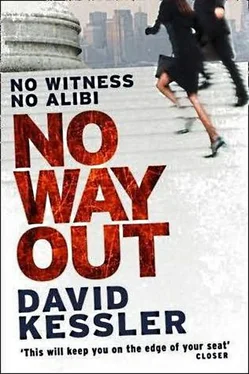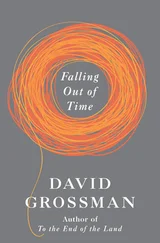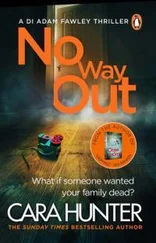David Kessler - No Way Out
Здесь есть возможность читать онлайн «David Kessler - No Way Out» — ознакомительный отрывок электронной книги совершенно бесплатно, а после прочтения отрывка купить полную версию. В некоторых случаях можно слушать аудио, скачать через торрент в формате fb2 и присутствует краткое содержание. Жанр: Триллер, на английском языке. Описание произведения, (предисловие) а так же отзывы посетителей доступны на портале библиотеки ЛибКат.
- Название:No Way Out
- Автор:
- Жанр:
- Год:неизвестен
- ISBN:нет данных
- Рейтинг книги:5 / 5. Голосов: 1
-
Избранное:Добавить в избранное
- Отзывы:
-
Ваша оценка:
- 100
- 1
- 2
- 3
- 4
- 5
No Way Out: краткое содержание, описание и аннотация
Предлагаем к чтению аннотацию, описание, краткое содержание или предисловие (зависит от того, что написал сам автор книги «No Way Out»). Если вы не нашли необходимую информацию о книге — напишите в комментариях, мы постараемся отыскать её.
No Way Out — читать онлайн ознакомительный отрывок
Ниже представлен текст книги, разбитый по страницам. Система сохранения места последней прочитанной страницы, позволяет с удобством читать онлайн бесплатно книгу «No Way Out», без необходимости каждый раз заново искать на чём Вы остановились. Поставьте закладку, и сможете в любой момент перейти на страницу, на которой закончили чтение.
Интервал:
Закладка:
Victor Alvarez, a man in his sixties with an air of the academic about him, entered the courtroom. He was in fact the Technical Leader of the DNA section of the Ventura crime lab and had done the analysis himself because it was such a high-profile case. He was sworn in and then asked a few preliminary questions to establish his qualifications and the fact that he worked at the lab where the DNA profiling was done. This was followed up by a detailed explanation of what DNA is, using the DOAR Digital Evidence Presentation System to illustrate his testimony with a series of diagrams and pictures — all delivered in his “wise old expert” tone.
He explained that DNA is made up of four so-called “bases,” referred to by the letters A, C, G and T, and that these bases formed pairs, but only in a very specific ways.
“A always pairs with T,” he explained, “and C can only pair with G.”
When he fell silent from this preliminary explanation, Sarah Jensen was ready to move on.
“Now could you explain how you use this to identify the source of the DNA?”
“There are certain particular sequences of DNA that vary a lot from one person to another. It is these sequences that we use for DNA analysis in criminal detection.”
“And how do you do this?”
“We look for something called Short Tandem Repeats, or STR for short. These are short sequences of DNA, normally of length two to five bases. These short sequences are in turn repeated between six and fifteen times at particular locations or loci. For example, a sequence like-”
He clicked to show the next chart. It showed a sequence of letters:
G-A-T-A-G-A-T-A-G-A-T-A-G-A-T-A-G-A-T-A-G-A-T-A
“That’s a sequence of four bases at a location known as D7S280. In this case there are six repetitions of the sequence G-A-T-A. Such a repeated sequence is called an allele. At each location you have a pair of alleles — as we call them — which might be either the same or different. So a person might have the GATA sequence six times in one allele and eight times at the other. Or they might have identical sequences at both alleles.”
“And how does this help identify the person?”
“Well different people have different numbers of repetitions of that particular sequence. In this particular case it can vary between six and fifteen repetitions.”
“But between six and fifteen means only ten possibilities?”
“Yes indeed.”
“So there must be lots of people who match that particular sequence?”
“Yes indeed. But we don’t look at just that one sequence. We look at thirteen different sequences. For any one sequence, many people may have the same number of repetitions. But once you start looking at all thirteen different sequences at different locations, then the likelihood of two people having the same number of repetitions as each other in each of the various sequences is extremely small. But the problem is that sometimes the amount of DNA in the evidence sample is extremely small.”
“So how do you deal with that?”
“By increasing the quantity.”
Thursday, 20 August 2009 — 11:30
Martine took the elevator to the fourth level of the parking structure feeling tense and flustered at the amount of time it had taken her to get here. She knew that the trial would have already started, but there was nothing she could do. She just hoped that she could get one of the stringers from the print press to fill her in on anything that she had missed.
There was nothing unusual to alert Martine as the elevator doors opened and she walked over towards her car. Parking structures held no fear for her, at least not in daylight. And there was plenty of daylight seeping in from the periphery to complement the strip lighting.
She pressed her combination on the remote key to open the car, ignoring the man moving things about on the front passenger seat of his aquamarine Mercedes in the adjacent parking spot. At the back of her mind, was the recollection that Elias Claymore’s missing car — like the one used in the rape of Bethel Newton — was the same make and color. And this man was…
She dismissed the thought, opened the driver’s door and slid into her car. She was just about to close the driver’s door when the man standing on the passenger side of the adjacent car lurched at her, shoved her hard into the passenger seat and slammed the door behind him. Before she could scream, he clamped an iron right hand over her mouth, his thumb under her jaw holding it shut. With his free left hand, he operated the mechanism to incline the seat back until it was almost horizontal. Then he started ripping at her clothes.
In those few seconds, terror truly engulfed Martine. They were high up, on the fourth level of the parking structure, so people were less likely to come here than to the lower levels and wouldn’t hear her outside on the street. It was not the beginning or the end of lunch-time so this would not be a key time for people to arrive here or leave. And this man was holding her down, so that she couldn’t be seen by others on this level, even if anybody came. Also he was strong and easily able to withstand her pathetic attempts at resistance.
Her skirt had by this stage been hitched up and her panties and pantyhose ripped off completely. He was now struggling with his own clothes and Martine could feel from the contact between them that he was already aroused physically as well as psychologically. The only thing she didn’t know, as she struggled to reach into her pocket, was whether he intended to let her live when he was finished with her.
Thursday, 20 August 2009 — 11:40
“So Polymerase Chain Reaction is a method of increasing the amount of DNA available for testing?”
Sarah Jensen was continuing her direct examination of Victor Alvarez.
“That’s right.”
“And how does it work?”
Alvarez pressed on the button to show an animation that he could speed up or slow down as he illustrated the process graphically.
“It involves heating and cooling the DNA in a special chamber called a thermal cycler, together with certain other chemicals called enzymes. This causes the DNA to unravel and split into separate strands and then each strand forms a new pair of strands with the other chemicals in the same way as it does in the body, with the bases forming pairs like I said before.”
“And how many times do you do this?”
“It can be anything from twenty-eight cycles to thirty-four. Each cycle doubles the amount of DNA.”
“But once you’ve got enough DNA for testing, how do you distinguish between DNA from the victim and DNA from the perpetrator of the crime?”
“We start off by defining threshold quantities. Anything that shows up in the test in a smaller quantity is simply treated as noise and therefore ignored. Then we look at the relative quantities of what’s left to identify what we call the ‘major contributor’ and the ‘minor contributor’. Next we compare the evidence sample to the victim’s reference sample to determine if the victim is the major or the minor contributor. We do the same with the suspect’s reference sample to see if the suspect matches the other contributor. If we find a sequence in the evidence sample that matches one found in the suspect’s reference sample, then we call that an inclusion . The more inclusions we find, the more likely it is that the suspect is the source of that DNA. On the other hand, if we find even one sequence that can’t be matched to the suspect or the victim, then we would call that an exclusion .”
“And how many exclusions does it take to exclude a suspect completely?”
“All it takes is one .”
Читать дальшеИнтервал:
Закладка:
Похожие книги на «No Way Out»
Представляем Вашему вниманию похожие книги на «No Way Out» списком для выбора. Мы отобрали схожую по названию и смыслу литературу в надежде предоставить читателям больше вариантов отыскать новые, интересные, ещё непрочитанные произведения.
Обсуждение, отзывы о книге «No Way Out» и просто собственные мнения читателей. Оставьте ваши комментарии, напишите, что Вы думаете о произведении, его смысле или главных героях. Укажите что конкретно понравилось, а что нет, и почему Вы так считаете.












